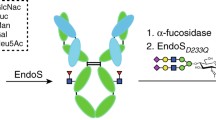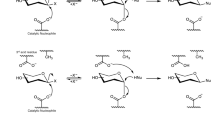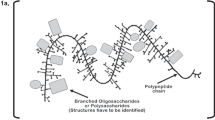Abstract
Galactose oxidase (EC 1.1.3.9, GAO) was used to convert the C-6′ OH of Galβ(1 → 4)Glcβ–OBn (5) to the corresponding hydrated aldehyde (7). Chemical modification, through dehydratative coupling and reductive amination, gave rise to a small library of Galβ(1 → 4)Glcβ–OBn analogues (9a–f, 10, 11). UDP-[6-3H]Gal studies indicated that α1,3-galactosyltransferase recognized the C-6′ modified Galβ(1 → 4)Glcβ–OBn analogues (9a–f, 10, 11). Preparative scale reactions ensued, utilizing a single enzyme UDP-Gal conversion as well as a dual enzymatic system (GalE and α1,3GalT), taking full advantage of the more economical UDP-Glc, giving rise to compounds 6, 15–22. Galα(1 → 3)Galβ(1 → 4)Glcβ–OBn trisaccharide (6) was produced on a large scale (2 g) and subjected to the same chemoenzymatic modification as stated above to produce C-6″ modified derivatives (23–30). An ELISA bioassay was performed utilizing human anti-αGal antibodies to study the binding affinity of the derivatized epitopes (6, 15–30). Modifications made at the C-6′ position did not alter the IgG antibody's ability to recognize the unnatural epitopes. Modifications made at the C-6″ position resulted in significant or complete abrogation of recognition. The results indicate that the C-6′ OH of the αGal trisaccharide epitope is not mandatory for antibody recognition. Published in 2004.
Similar content being viewed by others
References
Varki A, Biological roles of oligosaccharides: All of the theories are correct, Glycobiology 3, 97-130 (1993).
Sharon N, Lis H, Carbohydrates in cell recognition, Sci Am 268, 82-9 (1993).
Ellington AD, Szostak JW, In vitro selection of RNA molecules that bind specific ligands, Nature 346, 818-22 (1990).
Tuerk C, Gold L, Systematic evolution of ligands by exponential enrichment: RNA ligands to bacteriophage T4 DNA polymerase, Science 249, 505-10 (1990).
Lam KS, Salmon SE, Hersh EM, Hruby VJ, Kazmierski WM, Knapp RJ, A new type of synthetic peptide library for identifying ligand-binding activity, Nature 354, 82-4 (1991).
Bock LC, Griffin LC, Latham JA, Vermaas EH, Toole JJ, Selection of single-stranded DNA molecules that bind and inhibit human thrombin, Nature 355, 564-6 (1992).
Toshima K, Tatsuta K, Recent progress in O-glycosylation methods and its application to natural products synthesis, Chem Rev 93, 1503-31 (1993).
Barresi F, Hindsgaul O, Chemically synthesized oligosaccharides, 1994.Asearchable table of glycosidic linkages, J CarbohydrChem 14, 1043-87 (1995).
Karlsson-Parra A, Ridderstad A, Wallgren AC, Moller E, Ljunggren HG, Korsgren O, Xenograft rejection of porcine isletlike cell clusters in normal and natural killer cell-depleted mice, Transplantation 61, 1313-20 (1996).
McKane W, Lee J, Preston R, Hacking A, Simpson P, Lynds S, Goldberg L, Cairns T, Taube D, Polymorphism in the human antipig natural antibody repertoire: Implications for antigen-specific immunoadsorption, Transplantation 66, 626-33 (1998).
Wang L, Radic MZ, Galili U, Human anti-Gal heavy chain genes. Preferential use of VH3 and the presence of somatic mutations, J Immun 155, 1276-85 (1995).
Galili U, Andrews P, Suppression of a-galactosyl epitope synthesis and production of the natural anti-Gal antibody: A major evolutionary event in ancestral Old World primates, J Human Evol 29, 433-42 (1993).
McAuliffe JC, Hindsgaul O, Carbohydrate drugs-an ongoing challenge, Chem & Ind 5, 170-4 (1997).
Chen X, Zhang W, Wang J, Fang J, Wang PG, Production of alpha-galactosyl epitopes via combined use of two recombinant whole cells harboring UDP-galactose 4-epimerase and alpha-1,3-galactosyltransferase, Biotech Prog 16, 595-99 (2000).
Zhang J, Kowal P, Fang J, Andreana P, Wang PG, Efficient chemoenzymatic synthesis of globotriose and its derivatives with a recombinant ?(1,4)-galactosyltransferase, Carb Res 337, 969-76 (2002).
Zhang W, Wang J-Q, Li J, Yu L-B, Wang PG, Large-Scale Synthesis of an ?Galactosyl Trisaccharide Epitope Involved in the Hyperacute Rejection Upon Xenotransplantation, J Carbohydr Chem 18, 1009-17 (1999).
Fang J, Li J, Chen X, Zhang Y, Wang J, Guo Z, Zhang W, Yu L, Brew K, Wang PG, Highly efficient chemoenzymic synthesis of ?-galactosyl epitopes with a recombinant ?(1?3)-galactosyltransferase, J Am Chem Soc 120, 6635-8 (1998).
Chen X, Kowal P, Hamad S, Fan H, Wang PG, Cloning, expression and characterization of a UDP-galactose 4-epimerase from Escherichia coli, Biotech Lett 21, 1131-5 (1999).
Xu Y, Lorf T, Sablinski T, Gianello P, Bailin M, Monroy R, Kozlowski T, Awwad M, Cooper DKC, Sachs DH, Removal of anti-porcine natural antibodies from human and nonhuman primate plasma in vitro and in vivo by a Gal?(1?3)Gal?(1?4)Gle?-X immunoaffinity column, Transplantation 65, 172-9 (1998).
Taniguchi S, Neethling FA, Korchagina EY, Bovin N, Ye Y, Kobayashi T, Niekrasz M, Li S, Koren E, In vivo immunoadsorption of antipig antibodies in baboons using a specific Gal? (1?3)Gal column, Transplantation 62, 1379-84 (1996).
Andreana PR, Xie W, Cheng HN, Qiao L, Murphy DJ, Gu Q-M, Wang PG, In Situ Preparation of ?-D-1-O-Hydroxylamino Carbohydrate Polymers Mediated by Galactose Oxidase, Org Lett 4, 1863-6 (2002).
Andreana PR, Sanders T, Janczuk A, Warrick JI, Wang PG, Chemoenzymatic synthesis of polyhydroxyazepanes, Tetrahedron Lett 43, 6525-8 (2002).
Palcic MM, Hindsgaul O, Glycosyltransferases in the synthesis of oligosaccharide analogs, Trends Glycosci Glycotechnol 8, 37-49 (1996).
Elhalabi JM, Rice KG, Synthesis and applications for unnatural sugar nucleotides, Curr Med Chem 6, 93-116 (1999).
Ohrlein R, Glycosyltransferase-catalyzed synthesis of non-natural oligosaccharides, Top Curr Chem 200, 227-54 (1999).
Blanken WM, Van den E, Dirk H, Biosynthesis of terminal Gal? (1?3)Gal?(1?4)GlcN Ac-R oligosaccharide sequences on glycoconjugates. Purification and acceptor specificity of aUDPGal: N-acetyllactosaminide ?1,3-galactosyltransferase from calf thymus, J Biol Chem 260, 12927-34 (1985).
Mazur A, Galactose Oxidase. In: Enzymes in Carbohydrate Synthesis, edited by Bednarski MD (Oxford University Press, New York, 1991), pp. 99-110.
Osawa T, Irimura T, Kawaguchi T, Bauhinia purpurea agglutinin, Methods in Enzymology 50, 367-72 (1978).
Furka A, Sebestyen F, Asgedom M, Dibo G, General method for rapid synthesis of multicomponent peptide mixtures, Int J Pept Protein Res 37, 487-93 (1991).
Ohlmeyer MHJ, Swanson RN, Dillard L, Reader JC, Asouline G, Kobayashi R, Wigler M, Still WC, Complex synthetic chemical libraries indexed with molecular tags, Proc Nat Acad Sci USA 90, 10922-6 (1993).
Itoh S, Taki M, Takayama S, Nagatomo S, Kitagawa T, Sakurada N, Arakawa R, Fukuzumi S, Oxidation of Benzyl Alcohol with CuII and ZnII Complexes of the Phenoxyl Radical as a Model of the Reaction of Galactose Oxidase, Angew Chem Int Ed 38, 2774-6 (1999).
Sujino K, Malet C, Hindsgaul O, Palcic MM, Acceptor hydroxyl group mapping for calf thymus ?1,3galactosyltransferase and enzymatic synthesis of ?-D-Galp(1?3)-?-D-Galp(1?4)? DGlcpNAc analogs, Carb Res 305, 483-9 (1998).
Author information
Authors and Affiliations
Corresponding author
Rights and permissions
About this article
Cite this article
Andreana, P.R., Kowal, P., Janczuk, A.J. et al. Alpha-Galactosyl trisaccharide epitope: Modification of the 6-primary positions and recognition by human anti-αGal antibody. Glycoconj J 20, 107–118 (2003). https://doi.org/10.1023/B:GLYC.0000018585.66094.ff
Issue Date:
DOI: https://doi.org/10.1023/B:GLYC.0000018585.66094.ff




